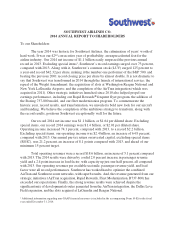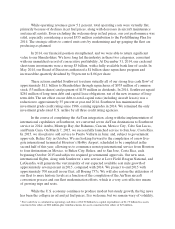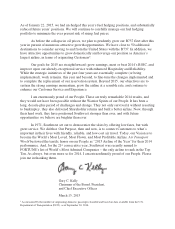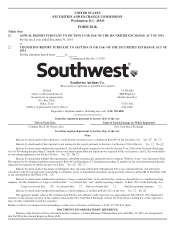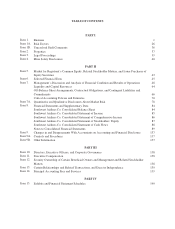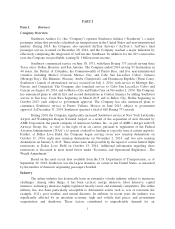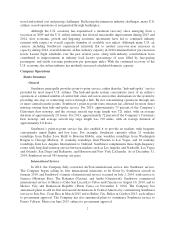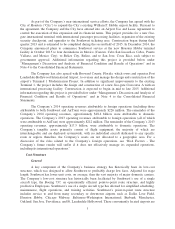Southwest Airlines 2014 Annual Report Download - page 10
Download and view the complete annual report
Please find page 10 of the 2014 Southwest Airlines annual report below. You can navigate through the pages in the report by either clicking on the pages listed below, or by using the keyword search tool below to find specific information within the annual report.travel and related cost and pricing challenges. Reflecting the numerous industry challenges, many U.S.
airlines ceased operations or reorganized through bankruptcy.
Although the U.S. economy has experienced a moderate recovery since emerging from a
recession in 2009 and the U.S. airline industry has showed measurable improvement during 2013 and
2014, slow economic growth and lingering economic uncertainty have led to continued industry
restraint with respect to overall capacity (number of available seat miles). Although many U.S. air
carriers, including Southwest, experienced relatively flat to modest year-over-year increases in
capacity during 2014, overall domestic airline industry capacity in 2014 remained below pre-recession
levels. Leaner flight schedules over the past several years, along with industry consolidation, have
contributed to improvements in industry load factors (percentage of seats filled by fare-paying
passengers) and yields (revenue production per passenger mile). With the continued recovery of the
U.S. economy, the airline industry has modestly increased scheduled domestic capacity.
Company Operations
Route Structure
General
Southwest principally provides point-to-point service, rather than the “hub-and-spoke” service
provided by most major U.S. airlines. The hub-and-spoke system concentrates most of an airline’s
operations at a limited number of central hub cities and serves most other destinations in the system by
providing one-stop or connecting service through a hub. By not concentrating operations through one
or more central transfer points, Southwest’s point-to-point route structure has allowed for more direct
nonstop routing than hub-and-spoke service. For 2014, approximately 73 percent of the Company’s
Customers flew nonstop, and the average aircraft trip stage length was 721 miles, with an average
duration of approximately 2.0 hours. For 2013, approximately 72 percent of the Company’s Customers
flew nonstop, and average aircraft trip stage length was 703 miles, with an average duration of
approximately 2.0 hours.
Southwest’s point-to-point service has also enabled it to provide its markets with frequent,
conveniently timed flights and low fares. For example, Southwest currently offers 21 weekday
roundtrips from Dallas Love Field to Houston Hobby, nine weekday roundtrips from Washington
Reagan to Chicago Midway, 11 weekday roundtrips from Phoenix to Las Vegas, and 14 weekday
roundtrips from Los Angeles International to Oakland. Southwest complements these high-frequency
routes with long-haul nonstop service between markets such as Los Angeles and Nashville, Las Vegas
and Orlando, San Diego and Baltimore, and Houston and New York LaGuardia. As of December 31,
2014, Southwest served 581 nonstop city pairs.
International Service
In 2014, the Company fully converted AirTran international service into Southwest service.
The Company began selling its first international itineraries to be flown by Southwest aircraft in
January 2014, and Southwest’s launch of international service occurred on July 1, 2014, with service to
Jamaica (Montego Bay), The Bahamas (Nassau), and Aruba (Oranjestad). Southwest commenced
international service to Mexico (Cabo San Lucas/Los Cabos and Cancun) on August 10, 2014, and to
Mexico City and Dominican Republic (Punta Cana) on November 2, 2014. The Company has
announced plans to add its first and second destinations in Central America by commencing Southwest
service to San Jose, Costa Rica in March 2015 and to Belize City, Belize in October 2015, each subject
to government approval. The Company has also announced plans to commence Southwest service to
Puerto Vallarta, Mexico in June 2015, subject to government approval.
2

